After this last hard freeze, I am hoping that the worst is behind us and we can confidently get out into the garden and whip things back into shape. While I realize February is still technically winter, it is also the beginning of spring for north westerners, and there is much to do before the actual spring season arrives. Here are some timely tasks to consider…
PRUNING: February is a key month for pruning a lot of things. We normally prune fruit trees this time of year, mostly to manage the fruit set rather than for their aesthetic qualities. Keeping limbs spaced for optimum air and light penetration helps immensely in controlling diseases, not to mention keeping the fruit within reasonable reach for harvesting. Generally speaking, anything that blooms in the summer (rather than the spring) can be pruned back severely now - including shrubs such as Roses, hardy Hibiscus, Butterfly Bushes and Pee Gee Hydrangeas. These plants produce flowers on the ends of their new growth, so pruning them now stimulates new growth and encourages more flowers come summertime. For plants that bloom now and on into spring like Rhododendrons, Azaleas, and Forsythia, we prune them after they finish blooming - the same is true for winter-blooming Heather. By pruning in the spring after they finish their bloom cycle, they have all season to set buds for the following year. It really does make sense when you think about it.
PERENNIALS: If you haven’t yet cleaned up your perennials, it is time to do so. “Mushers”, like Hostas, are easy since the old growth will just separate from the crown with your hands. “Sticks”, like hardy Fuchsias and Mums, require pruners to cut the old stems down, around half way for now. Once you see new growth in a month or so you can finish the project by removing any dead stems. Evergreen perennials, like Hellebores and Epimedium, that bloom in the winter need to have their old foliage removed now to make room for their flowers. Other evergreen perennials, like Heucheras, just need the old tattered leaves removed.
PLANTING: Believe it or not, there is quite a lot that can be planted this time of year, including hardy herbs, perennials and of course all sorts of trees and shrubs. Garden centers are busy stocking up and somethings sell out early, so don’t delay.
WEEDING: A quick trip with the Hula-Hoe around the garden can make waste of a lot of weeds in no time flat. After you have cleaned up, spread some lime and organic fertilizer, and cover the bare ground with an inch of compost to suppress further weed seed germination.
VEGETABLES: Root crops, like carrots, beets, onions, and potatoes, can be planted now. Broccoli, cauliflower, cabbage, kale, and peas can also go in the ground this month. Before you plant, always add some organic fertilizer, lime, and compost to the soil to get the best results from your growing efforts.
TAKE A LOCAL GARDENING CLASS: Lots of garden centers offer free gardening classes year ‘round. Check out their websites to see what they are offering. Here at Sunnyside, we have scheduled over 50 classes this year, so there is bound to be something of interest.
GO TO THE FLOWER AND GARDEN SHOW: Not to be missed, this is the premier garden show in the country and is a great way to get excited about the upcoming season. It runs February 15th through 19th at the Washington State Convention Center.
Okay, now that you have your assignment, I expect to see lots of progress this month. Hop to it and happy gardening!



